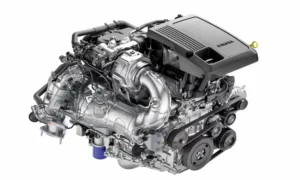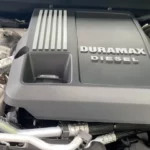Ever filled your Duramax’s DEF tank only to have the gauge stubbornly read “empty”? You’re dealing with a frustrating but fixable issue that’s affecting thousands of GM diesel owners. The good news? There’s an official fix, and you might not need expensive parts replacement.
Let’s dive into why your DEF sensor is lying to you, what you can do about it right now, and how to get it properly fixed without breaking the bank.
What’s Causing Your DEF Tank to Read Empty When It’s Full?
If your Duramax diesel is showing an empty DEF tank when you know it’s full, you’re experiencing a known widespread software problem affecting 2020-2024 models. This isn’t just a random glitch—GM has officially acknowledged the issue and released a fix through Service Bulletin 22-NA-150.
The culprit? A software anomaly in the K115 Reductant Control Module that makes the DEF level sensor go haywire. Your truck isn’t broken—it’s just confused.
Which Duramax Models Are Affected?
This DEF sensor issue impacts a wide range of GM vehicles with Duramax diesel engines, including:
- 2020-2024 Chevrolet Silverado 1500, 2500HD, and 3500HD
- 2020-2024 GMC Sierra 1500, 2500HD, and 3500HD
- 2020-2024 Chevrolet Tahoe and Suburban
- 2020-2024 GMC Yukon
- 2020-2024 Cadillac Escalade
Both the 3.0L LM2/LZ0 and 6.6L L5P Duramax engines can experience this problem. If you own one of these vehicles and are seeing DEF warnings despite having a full tank, you’re not alone.
Warning Signs Your DEF Sensor Is Malfunctioning
How do you know if you’re dealing with this specific issue? Here are the telltale symptoms:
- Your dashboard shows “DEF Empty Refill Now” despite having a full tank
- You see speed limit warnings (typically stating 500-800 miles until speed reduced to 65 MPH)
- The “Service Emission System” warning light illuminates
- Your Malfunction Indicator Lamp (MIL) turns on
- The DEF gauge jumps erratically between readings or stays stuck at empty
If you’re experiencing these warnings after filling your DEF tank, you’re likely dealing with the software issue covered by GM’s service bulletin.
Quick Temporary Fix While You Wait for Dealer Service
Need to keep driving while you wait for a dealer appointment? Many owners have found a temporary solution with a simple battery reset procedure:
Battery Reset Method
- Disconnect both negative battery terminals
- Wait 5-10 minutes (or touch the disconnected positive and negative cables together briefly to discharge faster)
- Reconnect your batteries
- Cycle the ignition 2-3 times without starting the engine
- Start the engine
This reset often clears the warnings temporarily, but don’t get too excited—the issue will likely return within a few days or weeks. Think of it as a band-aid, not a cure.
The Official GM Solution: Service Bulletin 22-NA-150
The permanent fix requires a visit to your GM dealership for a software update. According to the service bulletin details, here’s what they’ll do:
- Reprogram the K115 Reductant Control Module with updated calibration
- Verify your DEF tank level shows at least 35% in their diagnostic system
- Add DEF if the tank reads below 35%
- Perform a Reductant Fluid Tank Level Reset using their diagnostic tools
- Fill your tank completely with fresh DEF
- Clear any diagnostic trouble codes
The good news? This is primarily a software fix that takes less than an hour and requires no part replacement. Better yet, it should be covered under your emissions warranty.
| Service Step | Details | Time Required |
|---|---|---|
| Software Update | Reprogram K115 Module | 0.5 hours |
| System Reset | Reset DEF level sensor | 0.2 hours |
| DEF Fill | Add fresh DEF if needed | 0.2 hours |
| Total Time | ~0.9 hours |
When Is Hardware Replacement Actually Needed?
While most DEF reading issues are solved with the software update, there are cases where the sensor hardware itself has failed. Here’s how to tell if you might need more than just the software fix:
Signs of Actual Sensor Failure
- Diagnostic codes P203A13, P203C00, P206A13, or P205B64
- Physical damage to the sensor connector
- The problem persists even after the software update
If you’re quoted for a full sensor replacement without trying the software fix first, get a second opinion. Many owners have reported being charged $800-1,800 for unnecessary hardware replacement when the software update would have fixed the issue.
The Cost of Hardware Replacement (If Needed)
| Expense | Typical Cost Range |
|---|---|
| DEF Sensor Parts | $300-600 (aftermarket) to $1,000+ (OEM) |
| Labor | $500-700 |
| Total Cost | $800-1,800 |
Remember, most cases don’t require this expensive repair—insist on the software update first.
How to Maintain Your DEF System to Prevent Issues
While the main problem is software-related, poor DEF quality and improper maintenance can contribute to sensor problems. Here’s how to keep your DEF system healthy:
Use Quality DEF Fluid Only
The quality of your DEF fluid matters enormously. Always test DEF concentration when possible—it should be exactly 32.5% urea. Some tips:
- Buy DEF from reputable sources like dealerships or major truck stops
- Check the manufacturing date—DEF has a limited shelf life
- Store DEF in a cool, dry place away from direct sunlight
- Keep receipts when buying DEF to document quality issues
Avoid These Common DEF Mistakes
- Never overfill your DEF tank—this can cause crystallization around the sensor
- Don’t use tap water to dilute DEF—it must remain at the precise 32.5% concentration
- Avoid using DEF that’s been stored in extreme temperatures
- Don’t assume the cheapest DEF is good enough—quality varies significantly
The DEF Warning System: Understanding What’s at Stake
Ignoring DEF warnings—even false ones—can lead to serious consequences. Here’s what happens if you keep driving without addressing the issue:
- First warning: “DEF Low” with mileage countdown
- Speed limited to 65 MPH after countdown expires
- Eventually, speed limited to 55 MPH
- Finally, the truck enters “limp mode” limiting speed to 4 MPH
Even if your tank is actually full, the computer doesn’t know that—it will still enforce these restrictions based on what the sensor tells it.
Step-by-Step Guide to Getting Your DEF Sensor Fixed
Here’s your action plan for resolving this issue properly:
1. Document Everything
Before heading to the dealer:
- Take photos of your dashboard warnings
- Note down any error codes
- Record the date and mileage when the issue started
- Keep receipts from DEF purchases
2. Call Your Dealer With Specific Information
When scheduling service:
- Mention Service Bulletin 22-NA-150 specifically
- Ask if they’ve performed this update on other Duramax vehicles
- Confirm they have the latest calibration files
- Verify it will be covered under warranty
3. After the Repair
Once the dealer performs the update:
- Request documentation of what was done
- Ask them to note the software version installed
- Verify all warning lights are cleared
- Monitor your DEF gauge for a few weeks to ensure the fix worked
Real-World Examples: How Other Owners Fixed This Issue
Many Duramax owners have successfully resolved this problem. Here are some real experiences:
John from Michigan reported on the Duramax Forum that his 2021 Sierra had shown the empty DEF warning for months despite multiple fills. After requesting the specific service bulletin update, his dealer fixed it in under an hour at no charge.
Sarah in Texas was initially quoted $1,600 for a complete DEF sensor replacement on her 2022 Silverado. After showing the service manager information about the software fix, they performed the update instead, and her problem was resolved without any parts replacement.
Expert Tips for Duramax DEF System Maintenance
Beyond fixing the current issue, here are some expert tips to keep your DEF system trouble-free:
- Perform a battery reset before long trips if you notice intermittent warnings
- Use a DEF-specific funnel when filling to prevent contamination
- Consider carrying a gallon of quality DEF for emergencies
- If your truck sits unused for extended periods, try to keep the DEF tank at least half full
- Avoid filling with DEF that’s been sitting in extreme heat or cold
Why This Problem Happens: The Technical Explanation
For those curious about the technical details, here’s what’s happening:
The DEF level sensor works by measuring electrical conductivity through the fluid. The software issue causes the Reductant Control Module to misinterpret these readings, especially after temperature changes or when the DEF fluid’s concentration isn’t perfectly consistent.
The software update modifies how the module interprets these signals, making it more tolerant of small variations that previously triggered false readings.
Final Thoughts: Don’t Get Stuck With Unnecessary Repairs
The Duramax DEF tank reading empty when full is a well-documented issue with a straightforward fix. Don’t let anyone convince you to replace expensive hardware before trying the software update covered by GM’s service bulletin.
Stay informed, be persistent with your dealer, and you’ll get this fixed properly—likely at no cost to you under warranty. Your Duramax will be back to normal operation without those annoying false warnings.
Remember, this isn’t your fault—it’s a known software issue affecting thousands of vehicles, and GM has developed a specific solution for it. With the right approach, you’ll have this resolved quickly and can get back to enjoying your powerful Duramax diesel without the constant DEF warnings.















